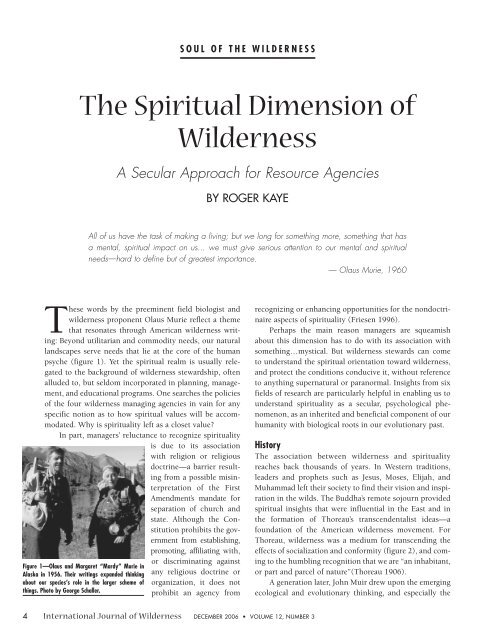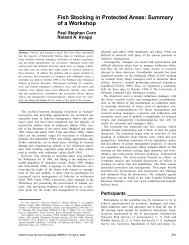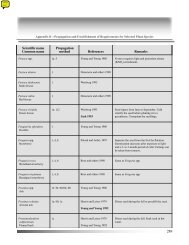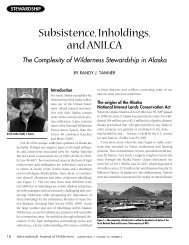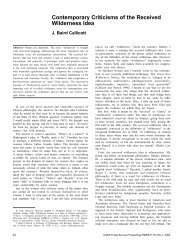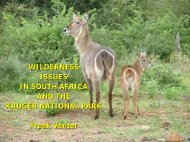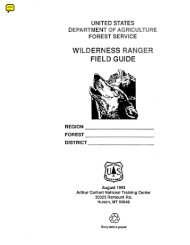The Spiritual Dimension of Wilderness - Wilderness.net
The Spiritual Dimension of Wilderness - Wilderness.net
The Spiritual Dimension of Wilderness - Wilderness.net
Create successful ePaper yourself
Turn your PDF publications into a flip-book with our unique Google optimized e-Paper software.
SOUL OF THE WILDERNESS<br />
<strong>The</strong> <strong>Spiritual</strong> <strong>Dimension</strong> <strong>of</strong><br />
<strong>Wilderness</strong><br />
A Secular Approach for Resource Agencies<br />
BY ROGER KAYE<br />
All <strong>of</strong> us have the task <strong>of</strong> making a living; but we long for something more, something that has<br />
a mental, spiritual impact on us... we must give serious attention to our mental and spiritual<br />
needs—hard to define but <strong>of</strong> greatest importance.<br />
— Olaus Murie, 1960<br />
<strong>The</strong>se words by the preeminent field biologist and<br />
wilderness proponent Olaus Murie reflect a theme<br />
that resonates through American wilderness writing:<br />
Beyond utilitarian and commodity needs, our natural<br />
landscapes serve needs that lie at the core <strong>of</strong> the human<br />
psyche (figure 1). Yet the spiritual realm is usually relegated<br />
to the background <strong>of</strong> wilderness stewardship, <strong>of</strong>ten<br />
alluded to, but seldom incorporated in planning, management,<br />
and educational programs. One searches the policies<br />
<strong>of</strong> the four wilderness managing agencies in vain for any<br />
specific notion as to how spiritual values will be accommodated.<br />
Why is spirituality left as a closet value?<br />
In part, managers’ reluctance to recognize spirituality<br />
is due to its association<br />
with religion or religious<br />
doctrine—a barrier resulting<br />
from a possible misinterpretation<br />
<strong>of</strong> the First<br />
Amendment’s mandate for<br />
separation <strong>of</strong> church and<br />
state. Although the Constitution<br />
prohibits the government<br />
from establishing,<br />
promoting, affiliating with,<br />
Figure 1—Olaus and Margaret “Mardy” Murie in<br />
Alaska in 1956. <strong>The</strong>ir writings expanded thinking<br />
about our species’s role in the larger scheme <strong>of</strong><br />
things. Photo by George Schaller.<br />
or discriminating against<br />
any religious doctrine or<br />
organization, it does not<br />
prohibit an agency from<br />
recognizing or enhancing opportunities for the nondoctrinaire<br />
aspects <strong>of</strong> spirituality (Friesen 1996).<br />
Perhaps the main reason managers are squeamish<br />
about this dimension has to do with its association with<br />
something…mystical. But wilderness stewards can come<br />
to understand the spiritual orientation toward wilderness,<br />
and protect the conditions conducive it, without reference<br />
to anything supernatural or paranormal. Insights from six<br />
fields <strong>of</strong> research are particularly helpful in enabling us to<br />
understand spirituality as a secular, psychological phenomenon,<br />
as an inherited and beneficial component <strong>of</strong> our<br />
humanity with biological roots in our evolutionary past.<br />
History<br />
<strong>The</strong> association between wilderness and spirituality<br />
reaches back thousands <strong>of</strong> years. In Western traditions,<br />
leaders and prophets such as Jesus, Moses, Elijah, and<br />
Muhammad left their society to find their vision and inspiration<br />
in the wilds. <strong>The</strong> Buddha’s remote sojourn provided<br />
spiritual insights that were influential in the East and in<br />
the formation <strong>of</strong> Thoreau’s transcendentalist ideas—a<br />
foundation <strong>of</strong> the American wilderness movement. For<br />
Thoreau, wilderness was a medium for transcending the<br />
effects <strong>of</strong> socialization and conformity (figure 2), and coming<br />
to the humbling recognition that we are “an inhabitant,<br />
or part and parcel <strong>of</strong> nature”(Thoreau 1906).<br />
A generation later, John Muir drew upon the emerging<br />
ecological and evolutionary thinking, and especially the<br />
4 International Journal <strong>of</strong> <strong>Wilderness</strong> DECEMBER 2006 • VOLUME 12, NUMBER 3
implications <strong>of</strong> the common origin <strong>of</strong><br />
all life, to preach that wilderness is<br />
particularly conducive to enabling<br />
people to see themselves as “a small<br />
part <strong>of</strong> the one great union <strong>of</strong> creation”<br />
(Muir 1918). Aldo Leopold<br />
(1987) further incorporated the spiritual<br />
implications <strong>of</strong> ecological and<br />
evolutionary thinking into the emerging<br />
wilderness ethic. <strong>The</strong> wilderness<br />
movement, he wrote, was “one <strong>of</strong> the<br />
focal points <strong>of</strong> a new attitude—an<br />
intelligent humility towards man’s<br />
place in nature.” Even the gung-ho<br />
Bob Marshall, late in his life, came to<br />
the realization that the dominant<br />
value <strong>of</strong> wilderness was “being part <strong>of</strong><br />
an immensity so great that the human<br />
being that looks upon it vanishes into<br />
utter insignificance” (as cited in<br />
Zahniser 1957). This diminishment<br />
<strong>of</strong> the self, the ego, and the sense <strong>of</strong><br />
connection with something timeless<br />
and universal was the central motivation,<br />
the spiritual motivation, <strong>of</strong><br />
<strong>Wilderness</strong> Act author Howard<br />
Zahniser, who was compelled by the<br />
belief that “we deeply need the<br />
humility to know ourselves as the<br />
dependent members <strong>of</strong> a great community<br />
<strong>of</strong> life” (Zahniser 1957).<br />
Psychology <strong>of</strong> Religion and<br />
Comparative Religion<br />
<strong>The</strong> unitive experience these wilderness<br />
movement leaders spoke <strong>of</strong> has a<br />
great deal in common with religious<br />
systems <strong>of</strong> thought and belief; so<br />
much can be learned from these<br />
fields. But we must keep in mind that,<br />
as research disciplines, their concern<br />
is not the object <strong>of</strong> spirituality. Rather,<br />
they are concerned with the common<br />
characteristics, benefits, and factors<br />
contributing to the spiritual experience.<br />
Whether religions are based on<br />
a God, animistic spirits, an Eastern<br />
philosophy <strong>of</strong> harmony and unity, or<br />
belief in one’s embeddedness in the<br />
natural world, they share a core function:<br />
<strong>The</strong>y replace the self as the<br />
“ultimate,” with a sense that the self is<br />
part <strong>of</strong> a larger, more enduring reality.<br />
In the words <strong>of</strong> psychologist<br />
Mihaly Csikszentmihalyi,<br />
they all provide a sense “that<br />
one belongs to something<br />
greater and more permanent<br />
than oneself” (1997). Historically,<br />
this has been expressed<br />
as a core wilderness precept.<br />
Its psychological universality<br />
suggests an innate<br />
underpinning—that there is<br />
Figure 2—Grand Canyon <strong>of</strong> the Yellowstone by Thomas Moran, 1872. Hudson<br />
likely an evolutionary<br />
River School <strong>of</strong> Art paintings (1820–1875) gave visual expression to romantic<br />
human predisposition for and transcendental ideas about spiritual experience in wilderness.<br />
this impulse for connection<br />
to some larger, greater, encompassing larger, more objective perspective.<br />
ultimacy.<br />
This transcendent perspective is one<br />
Clinical and Health Psychology<br />
Although not specific to wilderness,<br />
these fields provide empirical support<br />
for what the founders <strong>of</strong> the wilderness<br />
movement knew intuitively—<br />
that the kind <strong>of</strong> spiritual orientation<br />
many find in wilderness can be healthy.<br />
<strong>The</strong>y <strong>of</strong>fer functional definitions <strong>of</strong><br />
spirituality, provide psychometric<br />
scales to measure it, and document the<br />
positive effects spirituality can have on<br />
one’s physical and psychological wellbeing.<br />
Robert Emmons (1999) summarized<br />
research documenting that a<br />
spiritual orientation can lead to a<br />
lesser incidence <strong>of</strong> negative states,<br />
such as anxiety, stress, and depression,<br />
and can contribute to the positive<br />
states <strong>of</strong> satisfaction, optimism, and<br />
meaning and purpose <strong>of</strong> one’s life.<br />
Piedmont (2001) documented<br />
the positive correlation between such<br />
benefits and individuals whose orientation<br />
fits within this summary<br />
definition <strong>of</strong> spiritual:<br />
<strong>The</strong> capacity <strong>of</strong> individuals to stand<br />
outside <strong>of</strong> their immediate sense <strong>of</strong><br />
time and place and to view life from a<br />
in which a person sees a fundamental<br />
unity.<br />
Transcendence—rising above the<br />
narrow confines and concerns <strong>of</strong> the<br />
self—is the initial state one must pass<br />
through to find this enlarging capacity.<br />
And across research disciplines,<br />
across cultures, and throughout the<br />
foundational wilderness writings,<br />
this is what’s common to the definitions<br />
and descriptions <strong>of</strong> spiritual<br />
experience.<br />
Outdoor and<br />
<strong>Wilderness</strong> Recreation Experience<br />
<strong>The</strong>se fields provide a plethora <strong>of</strong><br />
studies wilderness stewards can draw<br />
upon to better understand the nature<br />
<strong>of</strong> this state and the benefits <strong>of</strong> attaining<br />
it. Employing interviews, journal<br />
analysis, and a variety <strong>of</strong> survey<br />
instruments, they provide qualitative<br />
descriptions <strong>of</strong> how, for many visitors,<br />
wilderness experience contributes to<br />
personal growth, and enhanced selfidentity,<br />
self-efficacy, and self-esteem.<br />
Yet although meaningful and beneficial,<br />
these self-constructs are not, in themselves,<br />
spiritual as many psychologists<br />
<strong>Wilderness</strong> is both a place and a system <strong>of</strong><br />
belief and feeling about our role in<br />
the larger scheme <strong>of</strong> things.<br />
DECEMBER 2006 • VOLUME 12, NUMBER 3 International Journal <strong>of</strong> <strong>Wilderness</strong> 5
Figure 3—<strong>Wilderness</strong> provides a sense <strong>of</strong> scale and the physical<br />
and temporal isolation from reminders <strong>of</strong> the everyday<br />
world that is conducive to transcendent experience. Photo by<br />
Roger Kaye.<br />
define spirituality. <strong>The</strong> work <strong>of</strong><br />
Marilyn Riley and John Hendee<br />
(2001) suggests that these “self”<br />
aspects comprise an initial, or<br />
prerequisite stage through which one<br />
must pass in the process toward<br />
transcendence—described by psychologists<br />
Steven Kaplan and Ja<strong>net</strong><br />
Talbot (1987) as their subjects’ emergent<br />
feeling <strong>of</strong> “a sense <strong>of</strong> union with<br />
something that is lasting, that is <strong>of</strong><br />
enormous importance, and they perceive<br />
as larger than they are” (p. 195).<br />
In examining the “wilderness<br />
effect,” psychologist Robert Greenway<br />
(1995) found that for many <strong>of</strong><br />
his subjects, a primary value <strong>of</strong> their<br />
trip was the “perceptual shift” they<br />
experienced. He found an expansion<br />
<strong>of</strong> the self, and a lessening <strong>of</strong> the ego<br />
and culturally reinforced individualistic<br />
thinking patterns. His term<br />
perceptual shift is worthy <strong>of</strong> attention<br />
because it lends insight into the<br />
actual nature, onset, intensity, and<br />
duration <strong>of</strong> transcendent experiences<br />
in wilderness. <strong>The</strong>y are seldom sudden,<br />
intense, ecstatic, or comparable<br />
to reported religious conversion<br />
experiences. In fact, the word experience<br />
may be misleading if taken to<br />
mean a discrete event or episode. As<br />
Barbra McDonald et al. (1989) have<br />
noted, the term spiritual growth better<br />
describes the gradual change in<br />
awareness more characteristic <strong>of</strong> the<br />
phenomenon.<br />
Csikszentmihalyi’s (1990) conceptualization<br />
<strong>of</strong> the “flow” state<br />
integrates findings from recreation,<br />
religion, and mental health research<br />
to enhance understanding <strong>of</strong> how the<br />
diminishment <strong>of</strong> self-consciousness<br />
contributes to this change. <strong>The</strong> concept<br />
was so named because his<br />
subjects reported that immersion in<br />
their experience was analogous to<br />
being on a river, “carried on by the<br />
flow” (Csikszentmihalyi 1991). Immersed<br />
in the trip, they were better able to<br />
forget, or hold in abeyance, awareness<br />
<strong>of</strong> status concerns and pressure<br />
to conform to socially defined roles<br />
and norms. In short, their perception<br />
<strong>of</strong> and relationship to the surrounding<br />
environment became less affected<br />
by the filter <strong>of</strong> their self-image.<br />
Solitude<br />
<strong>The</strong> popular literature describes solitude<br />
as a prerequisite condition for<br />
spiritual experience in wilderness,<br />
and many studies provide useful<br />
insights into its nature and role (figure<br />
3). Although the term solitude<br />
usually refers to some degree <strong>of</strong><br />
aloneness, privacy, or isolation, it is<br />
more appropriately defined as a state<br />
<strong>of</strong> mind, or way <strong>of</strong> being, that isolation,<br />
among other factors, is<br />
conducive to.<br />
William Hammitt’s “<strong>The</strong> Psychology<br />
and Function <strong>of</strong> <strong>Wilderness</strong><br />
Solitude” (1994) is among the psychometric<br />
studies that identify<br />
components <strong>of</strong> the experience and<br />
correlate them with the major<br />
causative factors. Characteristics <strong>of</strong><br />
the environment his subjects reported<br />
to be particularly important were the<br />
naturalness and peacefulness <strong>of</strong> the<br />
setting and its being free <strong>of</strong> humanmade<br />
intrusions. This is one example<br />
<strong>of</strong> the kind <strong>of</strong> study <strong>of</strong>fering muchneeded<br />
research-based rationale for<br />
protecting such conditions, and<br />
especially the last one—which begs<br />
the question…intrusions upon what?<br />
“Intrusions upon what” in psychological<br />
parlance is termed cognitive<br />
freedom. Its characteristics include<br />
the freedom to limit your attention to<br />
whatever you choose, to control your<br />
thoughts, and to be free <strong>of</strong> the expectations<br />
<strong>of</strong> others. Significantly, a<br />
characteristic <strong>of</strong> all spiritual traditions<br />
is the premise that concern with your<br />
self-image, status, and approval <strong>of</strong><br />
others are barriers to transcendence.<br />
Although the physical characteristics<br />
<strong>of</strong> wilderness, and the physical<br />
and temporal separation they provide,<br />
are especially conducive to<br />
attaining both solitude and spiritual<br />
experience, they are only contributing<br />
factors. <strong>The</strong> findings <strong>of</strong> Hollenhorst<br />
et al. (1994) on the most effective<br />
predictors <strong>of</strong> solitude achievement<br />
are as applicable to the more encompassing<br />
spiritual experience. It was<br />
not primarily the physical characteristics<br />
<strong>of</strong> the setting they conclude,<br />
“but rather predispositional factors<br />
that the visitor brings to the wilderness<br />
experience.” <strong>Wilderness</strong> is also a<br />
symbolic environment, a socially<br />
constructed behavioral setting. Like a<br />
church, cathedral, or monument to<br />
which it is so <strong>of</strong>ten compared, wilderness<br />
has become invested with<br />
meanings that make it prone to support<br />
spiritual interpretation and<br />
experience.<br />
Evolutionary Psychology and<br />
Neurophysiology<br />
A convergence <strong>of</strong> evidence from these<br />
fields is providing a growing body <strong>of</strong><br />
support for the idea that there are<br />
deeper predispositional factors at<br />
play than the learned beliefs, values,<br />
and expectations for spiritual experience<br />
that the visitor bring to the<br />
wilderness. <strong>The</strong>y support the theme<br />
that resonates through the wilderness<br />
literary tradition, represented by<br />
Murie’s reference to “attributes which<br />
we have inherited and developed<br />
through the ages…in response to an<br />
6 International Journal <strong>of</strong> <strong>Wilderness</strong> DECEMBER 2006 • VOLUME 12, NUMBER 3
inner urge that we still have and still<br />
do not fully understand” (1973,<br />
p.184).<br />
For example, Newberg and<br />
D’Aquili’s (2001) research on the<br />
neurological structures and processes<br />
that generate the spiritual experience<br />
provides compelling evidence that<br />
the spiritual urge is encoded in a<br />
genome that developed in synergistic<br />
evolution with the natural world. It’s<br />
part <strong>of</strong> our wiring as Homo sapiens.<br />
<strong>The</strong>ir findings are based on brain<br />
imaging studies <strong>of</strong> subjects in the<br />
midst <strong>of</strong> transcendent experience,<br />
described as “the absorption <strong>of</strong> the<br />
self into something larger.” To grossly<br />
simplify, within the limbic system<br />
they identified specialized bundles <strong>of</strong><br />
neurons that cause perceptions to<br />
reach one’s awareness through neural<br />
pathways less affected by the filter <strong>of</strong><br />
self-interest. Changes in the brain’s<br />
left parietal lobe were observed as<br />
subjects passed through stages <strong>of</strong> quiescence<br />
and came to a state that<br />
would help “free the mind’s awareness<br />
from the limiting grip <strong>of</strong> the<br />
ego.” As they summarized:<br />
We saw evidence <strong>of</strong> a neurological<br />
process that has evolved to allow us<br />
humans to transcend material<br />
existence and acknowledge and<br />
connect with a deeper, more spiritual<br />
part <strong>of</strong> ourselves perceived <strong>of</strong> as an<br />
absolute, universal reality that<br />
connects us to all that is. (2001, p. 60)<br />
What triggers this innate potential<br />
in some but not others? In brief<br />
summary, it’s the set <strong>of</strong> beliefs and<br />
expectations one brings to a setting<br />
that, because <strong>of</strong> its physical characteristics<br />
and associated meanings, is<br />
conducive to a perceptual shift.<br />
Conclusion<br />
Where did this predisposition come<br />
from, and why does it persist? What<br />
“mental and spiritual needs,” as<br />
Murie (1960) described, did it evolve<br />
to meet? We can only speculate as to<br />
<strong>The</strong> spiritual realm is usually relegated to the<br />
background <strong>of</strong> wilderness stewardship, <strong>of</strong>ten<br />
alluded to, but seldom incorporated in planning,<br />
management, and educational programs.<br />
how, through our biocultural evolution,<br />
it enhanced the fitness <strong>of</strong> our<br />
ancestors and the likelihood <strong>of</strong> their<br />
passing genes on to the future.<br />
Perhaps, as some evolutionary psychologists<br />
theorize, it emerged with<br />
the development <strong>of</strong> the brain’s neocortex,<br />
serving to relieve the psychic<br />
stress associated with the existential<br />
concerns that arose with the development<br />
<strong>of</strong> conscious thought. Perhaps<br />
in enabling our ancestors to sense<br />
their brief lives as part <strong>of</strong> a larger,<br />
more enduring reality, they were better<br />
able to deal with the new<br />
realization that they, as individuals,<br />
would die.<br />
But as wilderness stewards, we<br />
need not concern ourselves with the<br />
question <strong>of</strong> whether or to what<br />
degree the spiritual impulse originates<br />
in evolutionary process, social<br />
construction, or perhaps, divine<br />
intervention. We need only recognize<br />
that the longing to connect to an ultimate<br />
value larger than the self is<br />
ancient and has always been central<br />
to the idea <strong>of</strong> wilderness.<br />
Recent insights into the human<br />
mind’s workings enable understanding<br />
<strong>of</strong> and provision for the spiritual<br />
dimension <strong>of</strong> wilderness in psychological<br />
(secular) terms, thus making<br />
it a legitimate concern <strong>of</strong> sciencebased<br />
natural resource agencies. <strong>The</strong>y<br />
provide empirical understanding for<br />
what those who initiated the wilderness<br />
movement knew intuitively—<br />
the great importance <strong>of</strong> mediums<br />
such as wilderness for opening people<br />
to something within themselves<br />
that seeks relatedness to a greater<br />
meaning beyond themselves. This is<br />
the spiritual function—<strong>of</strong> wilderness,<br />
or a church, monument, memorial,<br />
shrine— <strong>of</strong> any consecrated place. An<br />
adaptive mechanism, the spiritual<br />
dimension <strong>of</strong> wilderness has evolved,<br />
is evolving, and will continue to<br />
evolve in response to changes in ourselves<br />
and our relationship to the<br />
natural world. <strong>The</strong> manifestation <strong>of</strong><br />
spirituality in the wilderness concept<br />
both reflects the unmet needs <strong>of</strong> our<br />
urban, utilitarian, commodity-driven<br />
culture, and reveals some archetypal<br />
part <strong>of</strong> us that this culture obscures.<br />
<strong>Wilderness</strong> is both a place and a<br />
system <strong>of</strong> belief and feeling about our<br />
role in the larger scheme <strong>of</strong> things.<br />
Geographically, wilderness is a remnant<br />
<strong>of</strong> our world that is still natural,<br />
wild, and free. <strong>Spiritual</strong>ly, it is a<br />
refuge for that part <strong>of</strong> ourselves that<br />
seeks connection, belonging, and<br />
rootedness within that world. IJW<br />
REFERENCES<br />
Murie, Olaus. 1960. Testimony Before the<br />
Merchant Marine and Fisheries<br />
Subcommittee on S. 1899, A Bill to<br />
Establish the Arctic Range, 1959, 86th<br />
Congress, 1st session, part 1, 1959;<br />
Washington, D.C.: GPO.<br />
Friesen, Jennifer. 1996. Nature, the human<br />
spirit, and the First Amendment. In<br />
Nature and the Human Spirit: Toward an<br />
Expanded Land Management Ethic, ed.<br />
B.L. Driver et al. State College, PA:<br />
Venture Publishing.<br />
Thoreau, Henry David. 1906. Walking. In<br />
Excursions and Poems, vol 5, <strong>The</strong><br />
Writings <strong>of</strong> Henry David Thoreau. Boston:<br />
Houghton Mifflin.<br />
Muir, John. 1918. A Thousand-Mile Walk to<br />
the Gulf. Boston: Houghton Mifflin.<br />
Zahniser, Howard. 1957. <strong>The</strong> need for wilderness<br />
areas. Living <strong>Wilderness</strong> (Winter-Spring,<br />
1956-57):<br />
Leopold, Aldo. 1987. A Sand County<br />
Almanac, and Sketches Here and <strong>The</strong>re<br />
(originally published 1948). New York:<br />
Oxford University Press.<br />
DECEMBER 2006 • VOLUME 12, NUMBER 3 International Journal <strong>of</strong> <strong>Wilderness</strong> 7


